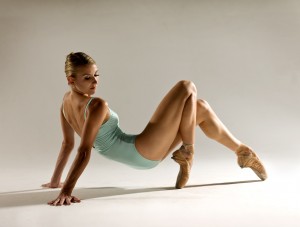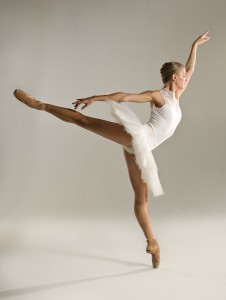Today’s “10 Questions With…” features Anne-Sophie Rodriguez…
1. How did you get involved with dance and what brought you to the United States?
When I was three years old, I started telling my Mom I wanted to dance. I had never seen dance, yet I knew that was what I wanted to do… She was able to hold me off for a few months but when she could no longer take my persistent asking, we went around to all the ballet schools in town. They all said I was too young, the minimum age being four. When we got to the last one, my Mom and I had a little powwow and decided to tell a little white lie and say I was four. When I actually turned four, we confessed to the school’s director who said she had figured it out but that I was doing very well and that it was fine. My family moved to the United States for my Dad to work in the Silicon Valley in the San Francisco Bay Area.
2. How was your ballet training different in the US as compared to France?
I was still very young when I left France so I suppose I can’t really compare the two that much. Of course, in France, I had French training while in the US, where I trained at the San Francisco and Boston Ballet Schools, I mostly had Russian teachers.

3. What project(s) are you currently involved in?
I currently free-lance so I am open to whatever comes my way! Last year, I danced with the Metropolitan Opera Ballet for the first time: it was amazing to be on that stage! Most recently, I have been performing with Janusphere Dance Company, a contemporary company, and compani javedani, a more modern company. My training was very classical so I am grateful that Sahar Javedani, Artistic Director of compani javedani, gave me the opportunity to go out of my comfort zone. She choreographed a beautiful solo on me and we plan to collaborate again soon.
Other than dancing myself, I also teach. I give private lessons as well as coach for the Ellison Ballet Professional Training Program. The school was founded by Edward Ellison, my coach and mentor who shares my main teacher from San Francisco Ballet School, Larisa Sklyanskaya. EBPTP just concluded its fourth year and most of the graduates have gone on to professional contracts in a time when jobs are hard to come by. Coaching is something I absolutely love, especially when seeing a tremendous improvement as I have with most of the students I have worked with.
4. Can you share the best piece of advice you have ever heard in terms of dance?
My teacher Larisa had many great sayings including “Don’t try, just do” as well as “you think you are, but you’re not.” She taught us to use the mirror as a tool to make sure our feelings matched up to what was actually happening. Most of the time, it wasn’t but little by little, we retrained completely and started to see the improvements we thought we were feeling at the beginning. I think a great piece of advice in life and in dance is that you are responsible for your own thoughts and actions. No one is to blame for anything but yourself and, with hard work, you can do anything you set your intentions on.
5. What was your best moment so far as a dancer?
I can’t think of a single best moment as a dancer. I have loved every part of rehearsing and performing. Even when everyone got bored with the numerous Nutcrackers (up to 50+ a year in Boston Ballet), I always reveled in each show. I enjoy bringing characters to life as well as dancing the same steps that have been passed down through generations and making them my own. I also love having work created on me.
6. What has been your biggest challenge as a dancer?

I think my biggest challenge has been that most directors see me in class and think I am very classical and that that is all I can do. It is true that, since most of my training was very Russian, that is what comes most naturally to me, however, with time to get it into my body, contemporary work is very enjoyable and I feel it looks good on me as well.
7. What would you say to a young ballet student who wants to do this as a career?
In order to be a dancer, you have to be fully committed. Dance is something you have to love as it is hard work and not always easy. However, fully committed does not mean not taking part in life outside the studio. Your experiences and relationships will inform your choices on stage, so be sure to get out there. The second part of my advice would be to get to know your body and what works and doesn’t work for it. Cross-training and injury prevention are necessary. Personally, I love yoga as it has the mind body connection that is so important in dance. Yoga has helped me become more aware of my body and how it moves in space. I also have an amazing body worker who does trigger point therapy and myofascial release, both of which I highly recommend for all dancers. Lacrosse balls are a great massage tool (to work on calves, gluteal muscles, etc) and I can no longer warm up properly without one!
8. Do you have a favorite step or combination? If so, what is it and why do you like it so much?
I am more suited to adagio-type work, not because I have especially high extensions but because I try to feel every moment and every note of the music. I take special care of my port-de-bras and pride myself on it. I also enjoy turning but I am not a trickster per se. Jumps are not my favorite in class, however they are more fun in rehearsal and on stage depending on what we are doing.
9. What type of pointe shoes do you wear, and do you have any special “tricks” you use to make them your own?
I have worn Russian Pointe, E 38 V3 W3, since they first brought them to the States. They mold to my feet well and are very comfortable. I unsew the back the fabric in the back and sew the vamp so it fits my foot well as there are no drawstrings in that style. I tend to glue the box after wearing them once so they will last longer. I find that gluing them before wearing them will make them too hard to break in.
10. What is next on the horizon for you?
As of right now, more of the same, dancing and teaching. I have been working on my BA with the L.E.A.P. program (Liberal Education for Arts Professionals) for the past couple years. The program started out in San Francisco and I was part of the inaugural NY group. We receive credits for our dance experience as well as life experience (as demonstrated by essays). I am enjoying the process, however I do hope to finish soon. Homework is the hardest part!
Bio: Anne-Sophie was born in France and started her studies there before moving to the San Francisco Bay Area. She spent most of her training at the San Francisco Ballet School with such renowned teachers as Larisa Sklyanskaya and Irina Jacobson. She later graduated from Boston Ballet School, having relocated there to study with Madame Tatiana Legat. Anne-Sophie has performed with such companies as Boston Ballet, Tulsa Ballet, The Norwegian National Ballet, The Metropolitan Opera Ballet, and Ballet Internationale. She currently free-lances, dancing with Janusphere Dance Company and compani javedani, and is very happy to be on the faculty of the Ellison Ballet Professional Training Program where she has the opportunity not only to work with mentor Edward Ellison but also with his dedicated students.





